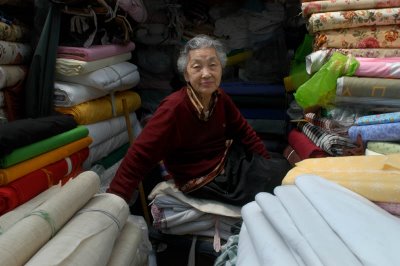
My Hangul is improving, albeit very slowly, every week. Through my interactions with the teachers, people at the gym, the ajummas at Kimbop Joongu and In-hye, my Korean teacher, I am becoming more and more proficient with the language. I pick up several words or phrases a week and try them out whenever possible. Through my triumphs and my defeats, I am piecing together the Hangul jigsaw puzzle.
Just today I found a big piece: The Hangul word for 'do.' In order to have something 'done,' many Koreans simply add the word 'do' to the noun in question. Want to make a hotel reservation? Just say "hotel reservation do," and they'll know exactly what you mean. Armed with this new information, I scored a modest victory against the seemingly impenetrable language barrier: I picked up the telephone and had lunch delivered. Paedal Haseyo. Delivery do.
There are three major problems with learning this seemingly simple language. The first and biggest issue surrounds the grammatical differences between English and Hangul. In English it is normal to first state the subject, then insert the verb and follow with the object acted on by that verb: I eat bread. In Hangul, The subject comes first, followed by the object and the verb is found at the end of a sentence. I bread eat.
Simple? Yes and no. It's like thinking backwards, which is easier than one might think when forming sentences. The real problems creep in when I listen to someone speaking Hangul. My brain, stuck in the subject-verb-object pattern I grew up with, often confuses the object for the verb. Complicating things further is that most Koreans do not speak in simple three-word sentences. Most Koreans speak Hangul like most Americans speak English, most conversations involving many more and varied parts of speech that I have yet to study: Indirect and direct objects, adverbs, adjectives and conjunctions just to name a few.
The second problem is vocabulary. The words are so alien, so completely unlike anything my ears have ever gathered before that unless I use or encounter a word multiple times a day (such as the word for 'give me'), it simply does not stick. There are exceptions (aren't there always?). I memorized the word for mountain trail, "san-kil," without anyone's help, and it came in handy while hiking Jangsan a few weeks back.
The third stumbling block centers around the particles. Speakers of Hangul attach all sorts of maddening little sounds onto the ends of words to indicate the speaker's relationship to the person spoken to, the direction, pronoun, subject, object, topic or indirect object. Ahhhhhhhh!!! So often these little sounds snag my mind and I lose focus as my brain tries to remember if 'eso' is the direction or placement marker. Compounding this is the myriad ways in which a verb can change tense. Most of the time all I hear when someone is talking to me in Hangul are a few nouns and simple verbs. I have to pretty much guess the rest.
So you can imagine my joy when a few weeks back my Korean teacher, In-hye, suggested we go on a picnic together. I told her (in English, of course) that I had heard the city of Jin-hae was THE place to be to see the cherry trees, which would blossom in early April. We would spend the whole day together, giving me ample opportunity to exercise my wimpy Korean language skills. The date was set for April 8th. April 8th was yesterday. This is my report from Jin-hae: Cherry blossom central.
We left early in the morning. The bus was crowded with blossom-enthusiasts dressed for the warm spring weather, backpacks slung over their shoulders, cameras around their necks. They chatted excitedly as we pulled away from the station. In-hye and I had to stand in the aisle.
The concrete canyon of the city came to an abrupt end at the wide Nakdong river, the gray-and neon gauntlet of PC rooms and apparel stores replaced by the earth-toned farming villages and shaggy brown-and-green hills of the countryside. Many of the steep mountainsides were bejeweled with clusters of wild pink cherry trees in full-bloom.
The festivities were just getting started when we arrived in Jin-hae. Vendors slow-cooked slabs of bone-in pork on motorized spits while ajummas stirred massive aluminum caldrons of steaming dwinjang jiggae. Wizened Marine veterans helped direct traffic and guide tourists.
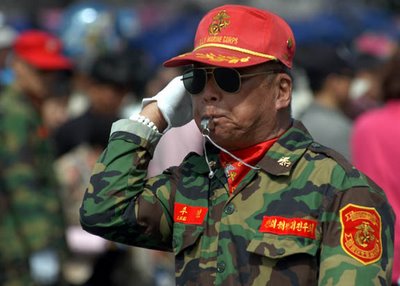
As the sun crept higher in the sky, the complexion-conscience Koreans covered their faces with whatever was on-hand.

In-hye and I caught a bus traveling to the local Naval Academy to see the Yi, Sun-shin museum. Though not his birthplace (as I reported in an earlier update), Jin-hae was the famed Admiral's post for much of his career. An extremely accurate 150-ton replica of his ironclad Geobukseon, or "Turtle Ships," is also floating on display at the academy. We couldn't pass this up.
The traffic was unreal, and the passengers in the bus baked as the bus inched its way towards the academy. "Top-da, top-da," said the rotund old woman sitting next to me over and over again as she fanned herself with the festival brochure. The slow pace allowed In-hye to catch up with her text-messaging while I stared out the window. Moored across the bay were five huge, low-slung Korean destroyers, their massive anti-shipping guns glistening in the sunlight. I had no idea the Korean navy was so modern.
The decks bristled with antiaircraft batteries and torpedo tubes. There were obvious launchers for cruise-missiles and some wicked-looking radar equipment clustered atop the mast. The ships were terrible to behold: Massive tools of war, the most modern instruments in an age-old symphony of death and diplomatic failure stretching back thousands of years. There was no mistaking the purpose of these ships: To end life, to kill people, lots of people, quickly and efficiently. It staggered my mind.
If only that much money and consideration went into preserving human life, I thought.
The bus finally arrived at its destination and my companion and I viewed the destroyer's wooden predecessor: The Geobukseon.

The line to go inside the replica was absurdly long. Still, In-hye and I tried to stick it out. While we waited, I photographed the sailors as they patrolled the concrete 'beach.'
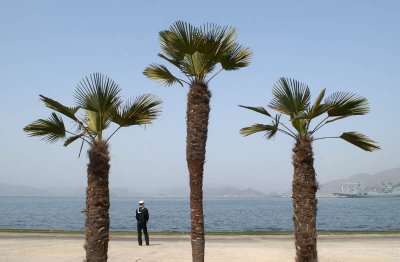
However, after fifteen minutes the line had moved only a few feet. In-hye and I decided to forego a proper inspection of the Geobukseon's interior. Instead we settled on a more-pedestrian examination of it's exterior. According to a plaque adjacent to the dock, the ship could travel at up to six knots. It sported a fire-arrow proof iron roof and sixteen holes in the wooden hull where canon would have normally been poking out. All that poked out of the port holes now was the occasional child.
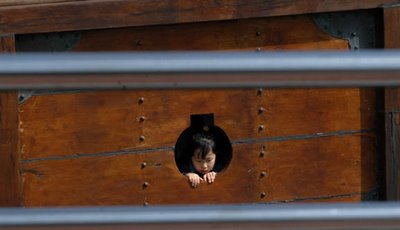
A tour through the Yi, Sun-shin museum gave me some accurate numbers on the famed Admiral. He was actually incarcerated following his demotion, and when the Joseon emperor finally broke him out and handed him what was left of the Korean Navy, he only had twelve ships. It was at that point that he turned these remaining ships into Geobuksan and trounced a Japanese force 133 warships strong.
Besides being an amazing naval commander, Sun-shin was also a poet and a scholar. This was a poem translated by the museum.
"By moonlight I sit all alone
In the tower on Hansan Isle
My sword is on my thigh
I am beside myself with care
From somewhere a shrill piping sound
Thrills and pierces my bowels"
Afterwards In-hye and I waited for a friend of hers from college to arrive with his car and pick us up so we wouldn't have to crowd onto another bus for the sweltering ride back to Jin-hae proper. I took a few shots of people hanging out by water front. The sailors from the academy were selling ice-cream. Children climbed all over the guns on-display.

In among the stationary weaponry was a 21-foot single-mast sailboat perched in a concrete cradle. "The Forerunner" was inscribed in the back and a plaque told the story of a young Korean man who sailed the tiny vessel from Los Angeles all the way across the Pacific Ocean to Busan in the 1990s. The voyage took seven months.
There were a lot of military families around, walking arm-in-arm with thei uniform-clad sons. I'm sure this family had a strong military background. Both this boy and his brother were in white officer's uniforms, presumably like their father's or grandfather's. Or maybe they're parents are just crazy. Who knows.

Other people sat under the cherry trees and waited for the bus. They took pictures of the flowers. I took pictures of them taking pictures of each other. Koreans love pictures.
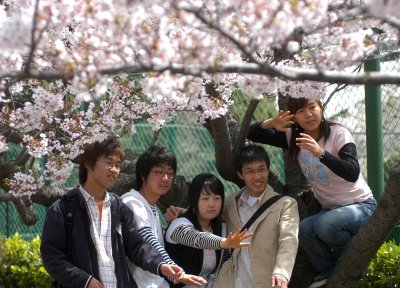

The beautiful pink cherry trees lined the driveway up to the academy's main building. The soldiers directing traffic made sure departing tourists drove down the driveway on their way out.

In-hye's friend Joseph pulled up at a half-past one in his tiny teal Matiz. The incredibly small car, which is a little smaller than a Honda Civic hatchback, has been affectionately nicknamed the "puppy car" by the Korean public. Joseph, a chemical engineer working for an oil-refining company, only paid eight million won, or about 8000 U.S. dollars, for the high-mileage car, and with good reason. Gas costs nearly six U.S. dollars per gallon here.
Both Joseph and In-hye are devote Christians. They attend church every Sunday almost without fail, and Joseph is lead guitarist in his church's praise band. "I used to be into rock and roll, metal," he said later on while we drove back to Busan. He had to go to practice that night, but he wanted to hang out with us until then.
One critical difference that I find between Christians in Korea and Christians in the United States is the level of proselytizing fervor. I have never, ever been accosted by Korean Christians wanting to know if I have been saved. Periodically, Mormons will hand me literature in the Lotte Underground Mall and speak a few words about where from and when I came, but they are not as pushy as some of the diehards I encountered in Mississippi. Most of the proselytizers I see handing out literature pass me up. Maybe they figure that I'm already Christian because I'm white. Or maybe they figure I'm damned to hell for the same reason. Who knows.
In-hye knows I don't go to church, and it doesn't seem to dissuade her from interacting with me. Neither she nor Joseph pushed their beliefs on me. All of our religious conversation centered on the gospel music they both enjoyed (and played) and Joseph's pivotal role in praise band. She knows nothing of my beliefs.
I paid close attention to the questions Joseph asked me during our day together. I was curious: What information is a priority to Koreans when confronted with a stranger from a strange land? The guidebooks say that due to the heavy influence of Mahayana Buddhism and Confusionism, many Koreans' pay close attention to age and social rank. These beliefs are closely linked to the language as well. With people who are older or of a higher rank Koreans use a more formal, respectful form of Hangul. With friends, a speaker simplifies the language. The "imnidas" and "sumnikas" fall off and give way to "da" and "ka."
Joseph's conversational manners bolstered this theory. One of the first questions he asked me concerned my job. Over lunch he asked my age and referenced his own. We used the neutral, informal-yet-polite form of Hangul common to most guidebooks with which to speak to one another. My hangul sucks. His English was good. You can guess which language we used the most.
While trying to find the big festival parade, we missed it completely. In-hye was really bummed, so instead we located and attended a dance performance in a square ringed with cherry trees. Dancers of all styles and traditions took the stage and performed for the crowd. In-hye and I parked ass on the concrete in front of the stage. While we waited for the first act, I photographed some of the performers getting ready "backstage."
These girls are leaning out of their van, watching as other dancers take the stage. I love how the cherry trees are reflected in the black-tinted glass.
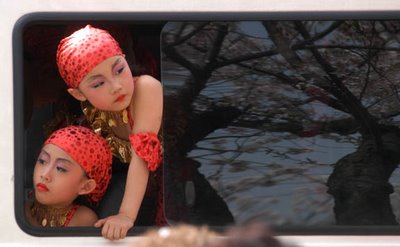
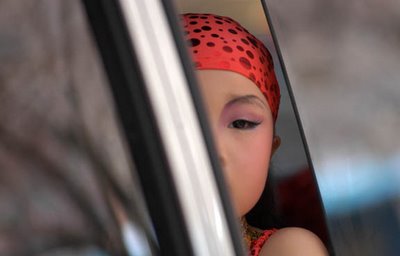
Like I said, there were dancers of all breeds: Korean traditionalists, dance-poets, hip-hop dancers and belly-dancers. Far and away the most compelling acts were the traditionalists. There were six women performing a host of ancient dances, all in Hanbok. The wore elaborate make-up.

Every time they took the stage the emcee would play the heart-stopping, thunderous drums and woodwinds of traditional Korean music. Even now, sitting in front of my computer, the memory of that boisterous, tumultuous music combined with the leaping, spinning, joyful movements of the dancers makes my eyes water. My heart is filled with emotion even as I write these words.
Following the traditional dancers would usually be a hip-hop act. A girl or girls, probably in their late teens, would take the stage and gyrate to Korean pop music, which on its face is really no different from American pop music. The only change is the language. The dancer's movements dripped with a sordid, soulless sexuality, the kind one finds in rap videos and live Brittany Spears performances.
Some of the traditional Korean dances were no less sexually suggestive, but there was a difference. Perhaps it was their scintillating, unwavering smile, or perhaps it was due to the careful subtlety of their gyrations, but I the dancers spoke to a deeper connection, a relationship between both sides of the human equation unexpressed by the aggressively sexual hip-hop and jazz dancers.


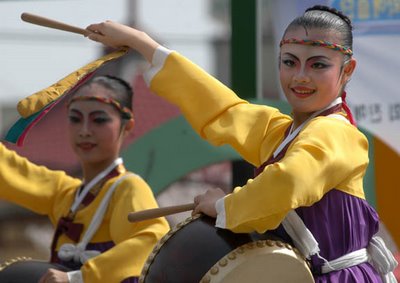
Following the performance, we piled into Joseph's "puppy car" in search of cherry trees. We chanced across a railroad track swarming with people, the verge by the rails lined in tall, majestic cherries. Joseph let In-hye and I out by the tracks and he parked the car as we began walking down the tracks. We balanced on the rails as the falling white petals danced in the air all around us. Children laughed as they ran with their arms outstretched, trying to catch the "spring snow."


At five o'clock we had to leave so Joseph could practice with the church praise band. We ate KFC before parting company. All in all, it was a very good day. There are no Korean Files this weekend. It has taken me five hours to put all of the above information down, and I'm finished for this week. Spring is the season for touring and festivals. Next weekend Mr. Kim is treating the whole staff to a trip from Busan all the way to the west coast of the peninsula. It will start at 6AM on Saturday and take us all the way till late Saturday night. Furthermore, next weekend is the start of the Gyeong-ju Dok and Dong Dong Ju festival. Rice cakes and booze in Korea's holy city. I promise to have a full report, including pictures, next Sunday. I hope everyone is doing really well. Peace. --Notes
1 comment:
Just a quick note, "Hangul" is the script, "Hangukmal" is the language.
Fantastic pictures, in this post and in the others.
Post a Comment